Peugeot 208 (2012-2019) Review
Written by Andrew Brady
Quick overview
Pros
- Attractive styling
- Very efficient engines
- Interior feels different
Cons
- Doesn’t quite drive with old-school Peugeot magic
- Rear-seat space isn’t great
- You need to choose engines carefully: some are great, others less so
Overall verdict on the Peugeot 208
"In this Peugeot 208 review we are looking at the another offering in a long line of impressive small cars from the French manufacturer. The small hatch market is always packed with quality but the Peugeot 208 stands out on account of its interesting design inside and out, practicality and solid driving experience. It may not be at the top of your shortlist but is well worth serious consideration if you're after a small car."
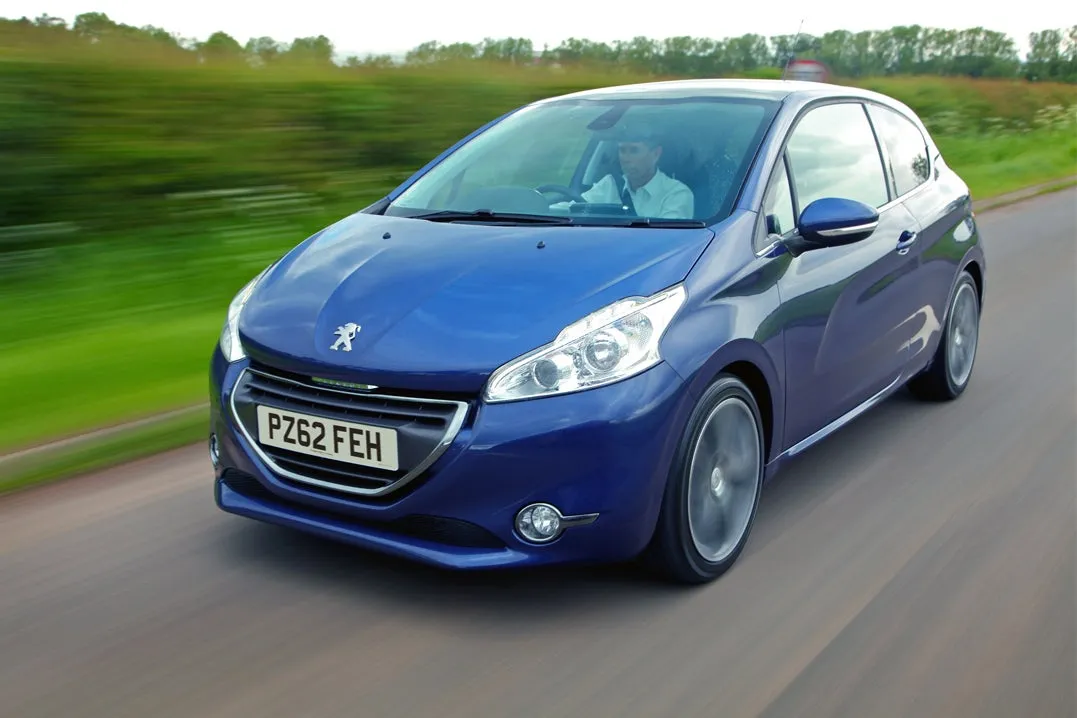
Peugeot has delivered front-running small hatches for decades and the Peugeot 208 carries on this form. It looks upmarket and classy, yet has a sporty air, too. There was more than the odd styling cue that referenced the classic Peugeot 205, including the shape of the rear pillar, complete with an inset panel that carried the legendary ‘GTI’ script on the sportiest version. As a used car, the Peugeot 208 makes a lot of sense as we'll find out in this review.
There was nothing evolutionary about the interior, though. This was an entirely new layout based around a tiny steering wheel and instrument binnacle mounted up high. Peugeot christened it ‘i-Cockpit’ and it presented drivers with the unusual concept of looking at the instruments over the steering wheel, rather than peering at them through the wheel itself.
The rest of the cabin was smartly finished with, rather like the exterior, nice attention to detail and some upmarket details. It was designed around a centrally-mounted touchscreen, but not all cars actually had the screen, with the button-packed stereo looking a bit misplaced on cheaper models. You really do need the colour screen to get the best effect.
Where the Peugeot 208 couldn’t quite match the magic of the 205 was in the way it drives. It was neat and tidy, and rather good fun by class standards. That tiny wheel promised a much more go-kart-like drive than was actually delivered, however. Ride quality also didn’t quite have the typical Gallic pliancy that used to characterise French cars.
Peugeot 208 engines were surprisingly high-tech compared with the middling motors that went before. The 1.2-litre VTi engines had variable valve timing and were sweet-revving, while 1.6-litre VTi engines delivered more power. There were turbocharged range-toppers too, a 1.6-litre THP with either 156PS or, in the 208 GTI, 200PS. Diesel engines were strong, again in that regular Peugeot way, with the 1.6-litre e-HDi delivering effortless drive in either 92PS or 115PS guises.
Even though this is a car built for the city, you’re better off sticking with a manual-gearbox Peugeot 208. It may have a disappointingly sloppy shift, but the alternative is either a neck-jolting automated manual called ECG, or a lethargic regular automatic in 1.6 Puretech guise.
The Peugeot 208 was updated in 2015. It didn’t need much, as it was such a pretty car anyway, although the neat LED front and rear lights are appealing. Revised engines were even better – 1.0-litre or 1.2-litre Puretech, and the choice 1.2-litre turbo Puretech that produced 110PS. Revised BlueHDi diesels were introduced too, some delivering record-breaking fuel economy.
Today, the Peugeot 208 remains an appealing, attractive car that feels just a slight cut above the rest. It is practical, has generally proven to be reliable, and should be very cheap to run. With prices now getting very affordable for early cars, read on to find out what you need to know.
If you're looking for the newer version, you need our Peugeot 208 (2020-) review.
heycar has 1000s of used cars for sale, including a wide range of Peugeot 208s for sale.
Is the Peugeot 208 right for you?
The Peugeot 208 is a safe, solid choice. It feels that bit more special than something like a Vauxhall Corsa, with a dash of style and panache. It’s a car that’s aged gracefully, and the early models certainly don’t look their age, despite the impressive value for money they now deliver.
Most of the engines are sound, particularly the later, post-facelift Puretech units. You’ll get decent miles per gallon plus okay performance and refinement. The diesels are particularly strong, as they are genuine fuel-sippers with plenty in reserve.
The Peugeot 208 also has its novel interior, which is far from mainstream. It will certainly feel weird at first, but many find that once they get used to it, they love the airy feel and, again, the still-modern appearance. Add in reasonable practicality and low running costs for the classy Peugeot’s appeal to be clear.
What’s the best Peugeot 208 model/engine to choose?
It’s a safe bet to go for a 1.2-litre engine: the 1.0-litre (and earlier 68PS 1.2-litre) is just a bit too light on pulling power, and the 1.6-litre non-turbo engine somehow disappoints (despite it being shared with the MINI hatchback).
If you’re going for a 1.6-litre, go for a THP version – ideally the fruity GTI, which has bags of grown up performance. There was an early 1.4-litre VTI too, which produced 95PS, and is a decent all-rounder – if not as economical as the 1.2-litre.
Diesels are strong, just as they always have been with Peugeot. The post-facelift BlueHDi engines are exceedingly fuel-efficient and meet the very latest emissions standards. So you won’t be excluded from city centres any time soon.
Entry-level trim is Access, and is just a bit too basic. You get air-con on Access+, but we prefer Active, which gets alloy wheels, the multifunction touchscreen, and an all-important USB input to bring your smartphone life into your car. Allure is the fancy trim and, early on, Peugeot offered two decadent variants: Feline and XY. Then there’s the GTI, whose red-pinstriped appeal is obvious.
What other cars are similar to the Peugeot 208?
If we’re talking French hatchbacks, we naturally have to mention the classy Peugeot’s most feared rival, the Renault Clio. That’s a car with pretty styling and an upmarket air of its own. The Citroen C3 is the sister car to the 208, but only really a genuine alternative in the latest-generation guise, launched in 2017.
Best-sellers include the Ford Fiesta, Vauxhall Corsa and Volkswagen Polo, and the latter has its own sister models: the SEAT Ibiza and Skoda Fabia.
The Honda Jazz is a roomy alternative, the Toyota Yaris has petrol/electric hybrid appeal, while the Mazda 2 is a sporty competitor to the Peugeot.
Comfort and design: Peugeot 208 interior
"The 208’s elegant, well-proportioned exterior is supported by an interesting and distinctive interior design. The first thing you’ll notice is the tiny steering wheel, much smaller than in any rival, which is positioned nice and close to the driver."
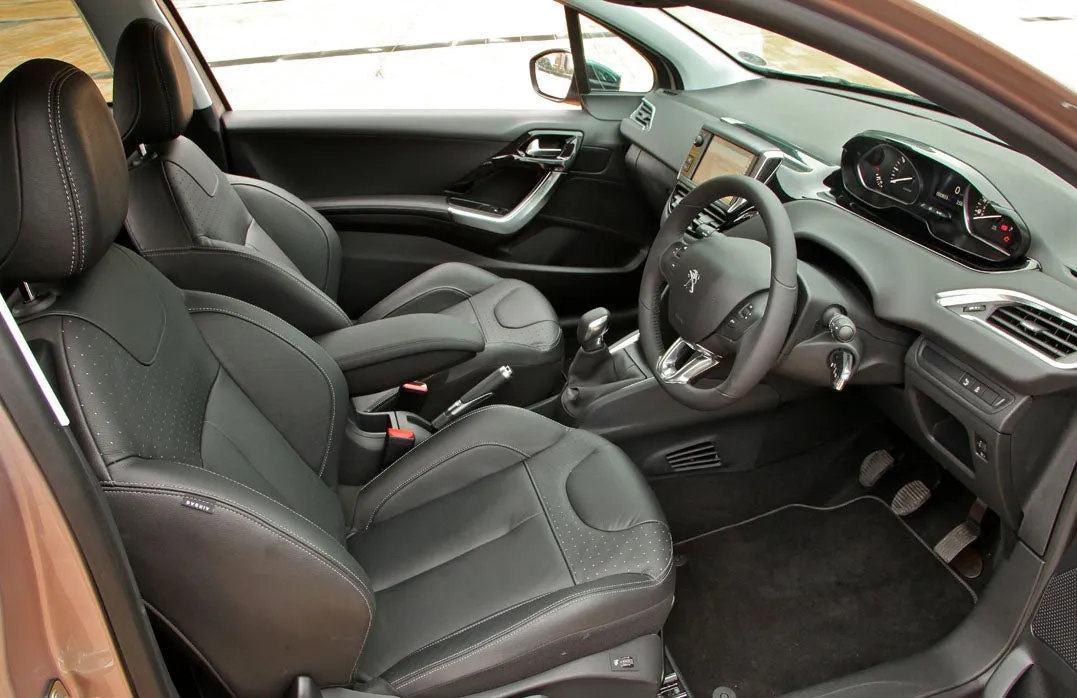
The wheel feels odd at first. It sits almost on your knees and we guarantee the first thing you will do is try to raise it up so you can see the instruments through it. You won’t be able to: it’s a completely different layout where you stare at the dials above the wheel rather than through it. Peugeot believes this creates a more open-plan interior and allows the design to be more sculptural and interesting.
It's certainly that. The Peugeot 208’s dashboard has flowing lines that give it a sense of multi-layered depth. It makes most of its rivals seem plain and boring, particularly as the stand-proud centre console shows off the central touchscreen so prominently. It’s still a layout that feels modern and contemporary, despite being launched more than ten years ago, which shows how forward-thinking the design was.
The front seats are comfortable, particularly as you move up the range and get to enjoy nicely bolstered chairs. They’re particularly good in the Peugeot 208 GTI. Even the steering wheel is good to hold, with a nice chunky design and gleaming Peugeot lion in the centre.
Quality and finish
Peugeot hasn't always enjoyed a great reputation for quality, but the classy-looking Peugeot 208 shows how much it’s moved on. It looks smart from the outside, with smooth surfaces, some lovely metallic colours and, on posher variants, a particularly upmarket chrome finisher around the windows.
Move inside and it doesn’t disappoint. The dashboard has an upmarket soft-touch upper surface, set off by some nice trim materials including piano black and polished chrome on some versions. Even the basic version gets piano black interior door pulls, polished door handles and a smart set of backlit instruments. None of the seat upholstery materials look downmarket either.
You need to move up through the range to enjoy features such as leather steering wheels, while the basic stereo that sits in place of the touchscreen looks poor quality. It is possible to pick out cheaper plastics lower down the dashboard, too. But generally, the Peugeot 208 has a quality of finish that may surprise many.
Infotainment: Touchscreen, USB, nav and stereo in the Peugeot 208
All but base Access versions of the Peugeot 208 feature a central colour touchscreen infotainment system. It isn’t the most responsive of screens, using more old-fashioned tech. But it’s still reasonably comprehensive, offering a basic form of smartphone control when you plug in your device, plus audio controls (DAB and Bluetooth are standard), and trip computer information. Sat-nav was an option.
Good news for those purchasing a 2015-on 208: following the facelift, Apple CarPlay was standard, along with MirrorLink to pair with other brands of smartphone. It means that even if you don’t have sat-nav fitted, you should be able to access it via your mobile device.
A colour reversing camera was also fitted to some Peugeot 208s, again using the central touchscreen.
Space and practicality: Peugeot 208 boot space
The Peugeot 208 feels grown up behind the wheel, thanks to its supportive seats. Once you’re used to the bizarre-at-first driving position and instrument positioning, you realise the space opened up by the tiny steering wheel makes it feel airier and more open-plan.
The steering wheel also has lots of adjustment, both up and down, and in and out. It’s a pity this is spoiled by pedals that are positioned much too close together. This means taller drivers have to move the seat too far back, or put up with a knees-splayed driving position that is further heightened by, yes, the tiny and low-set steering wheel.
Passengers will feel comfortable, though. The dashboard is cut away and the side windows drop down low, giving a bright and panoramic view out to the sides. Even locating the door mirrors further back adds to the feeling of spaciousness: you get a view forwards through the little front quarterlights.
Rear-seat space isn’t so great – particularly behind a taller driver, as they’ll have to shove the seat backwards to compensate for the pedals, which are located too close. Overall, space is no better than average, and if those in the front won’t compromise, it’s decidedly cosy back there. At least five-door models are a bit easier to get in and out of than the awkward three-doors – bear this in mind if fancy a 208 GTI as an everyday family car.
The boot is a bit below average in terms of space, carrying 285-litres with the seats up. The load lip is also pretty high. With the rear seats folded, the boot extends to a more impressive 1152-litres. The space is reasonably wide and the flat sides mean it’s a practical shape.
The Peugeot 208's dimensions are 3962mm long, 2004mm wide and 1460mm tall.
Handling and ride quality: What is the Peugeot 208 like to drive?
"Small Peugeots used to be all about driver engagement. But the Peugeot 208 is a much more mature and grown up performer, albeit with a little of the old Peugeot magic in places."
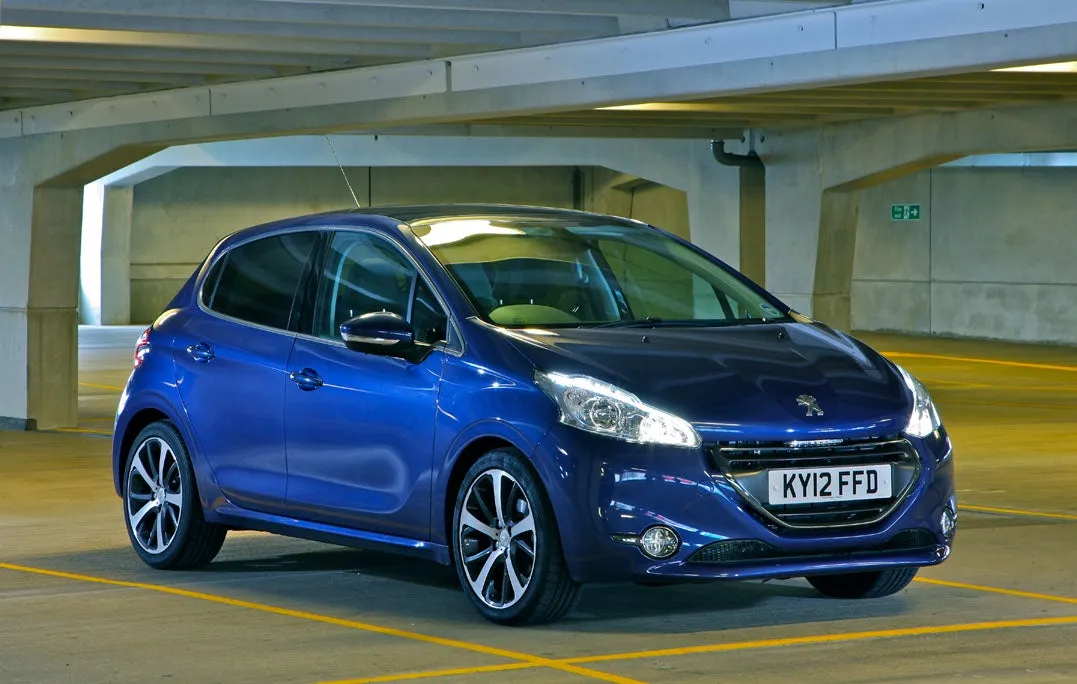
The suspension remains pleasingly roll-free through corners, even in more basic versions. It’s easy to thread along twisting roads as quickly as the smaller-sized engines will allow. This is great for maintaining momentum and extracting every last drop of power from the fuel-efficient motors.
It’s a shame the steering doesn’t deliver more feedback, though. Yes, it’s very quick, darting from lock to lock with alacrity. But the action itself is disappointingly remote, which means you don’t quite have full confidence to exploit the speed of the system.
As for ride quality, the Peugeot 208 is set up to be a little sportier than, say, its sister car, the Citroen C3. You can tell this by the reduced amount of roll through bends, but also in the slightly firmer and more irritable ride quality. It seems to pick out surface knobbles a little too keenly, and has a decidedly pernickety edge on versions with larger alloy wheels.
The salvation comes when the suspension is worked harder. There, you’ll discover the Peugeot 208 has strength in depth, coping with challenging roads without throwing in the towel. It’s not as fluid and free-flowing as famous Peugeots of old, but it seems to have a bit more resilience than some small cars, which should see driver confidence grow.
What engines and gearboxes are available in the Peugeot 208?
We like Peugeot 208s with smaller engines. They are sweet and surprisingly willing cars, able to make the most of their somewhat meagre power outputs with free-spinning eagerness. Okay, the least powerful models are probably a stretch too far, so we’d perhaps avoid the 68PS 1.2-litre VTi and 1.0-litre Puretech.
However, the 82PS 1.2-litre Puretech belies its so-so 0-62mph time with a charming energy that sees it happily driven in a vocally flat-out manner all day long without complaining. Better still is the turbocharged 1.2-litre Puretech 110, which has more pulling power lower down in the rev range, and even more smoothness and bite higher up. It’s a superb engine and really suits the 208 well. We prefer it to the earlier 1.4-litre VTI 95, although this is still worth considering if you want an early 208 with more poke.
The non-turbo 1.6-litre motors are ill-suited to the Peugeot 208. If you want a bigger engine and more power, make sure it’s a THP turbo. Or you could go for a diesel, which are rattlier, but still authentically French and so very easygoing. A 1.6 BlueHDi 100 motor feels like it could effortlessly drive all day long without pausing for breath – and so impressive is the fuel economy, it probably could do exactly that.
The manual gearbox in the Peugeot 208 is on the sloppy side. It’s an odd combination of lethargic heaviness and stodgy vagueness. It’s very French, but at least the clutch is light. And the alternative is far worse.
The EAT6 automated manual gearbox will drive you to distraction. It seems to always change gear at the wrong moment, takes an age to snick into the next gear, and delivers a nodding-dog-style lack of smoothness that is anything but appealing. The alternative, a regular automatic paired with the 1.6-litre engine, feels dreary and unenthusiastic. You’ll be longing for the manual before the test-drive is complete.
Refinement and noise levels
Peugeot’s little petrol engines aren’t bad for refinement. They’re not exactly silent, but the noise they make isn’t too objectionable, and their characterful enthusiasm seems to suit the Peugeot 208. The larger petrol engines drone more, although the THP turbo does have plentiful power. That means you don’t have to drive it particularly hard, which helps refinement.
As expected, the diesels are clattery – it’s hard to conceal diesel noise in cars this small – but the later BlueHDi engines are noticeably better in this regard. And the diesels do cruise very well, thanks to their relaxed, tall gearing.
The Peugeot 208 isn’t class-leading in other respects for noise, with apparent road roar and wind rustle. It’s by no means disastrous, but again, it does remind occupants that this is a small car pretending to be a large one, rather than one that benefits from big car refinements.
Safety equipment: How safe is the Peugeot 208?
In 2012, the Peugeot 208 was awarded a full five-star crash safety score by independent test body, Euro NCAP. The score was helped by the standard fitment of electronic stability control, and also a speed assistance system – Peugeot’s cruise control system offered, at the flick of a switch, a speed limiter that meant you could set a maximum speed and the car would not allow you to exceed it.
There are no knee airbags in the Peugeot 208, but it does offer front, side and curtain airbags – the latter extending to the rear seats as well. The front seats also have seatbelt pretensioners and load limiters.
ISOFIX is standard on the outer rear seats, but not on the front passenger seat, and it lacks an airbag cut-off switch. Also, while there’s a seatbelt reminder for the front seats, the rear seats miss out on this.
With the 2015 facelift, Peugeot introduced an optional safety kit that included an Active City Brake function. At speeds of up to 20mph, it would alert the driver about an obstacle ahead and, if he or she didn't react, automatically apply the brakes. Many used models have this fitted, and it’s a piece of safety equipment that’s worth looking out for.
MPG and fuel costs: What does a Peugeot 208 cost to run?
"Excellent fuel economy is guaranteed in almost every Peugeot 208. The tiny engines are the best, with official fuel economy of almost 66mpg from the 1.0 VTI and the same from the 1.2 Puretech. Of course, you won’t get this in everyday use, particularly if you’re working the engines hard, but it’s still a sign of the engines’ overall efficiency."
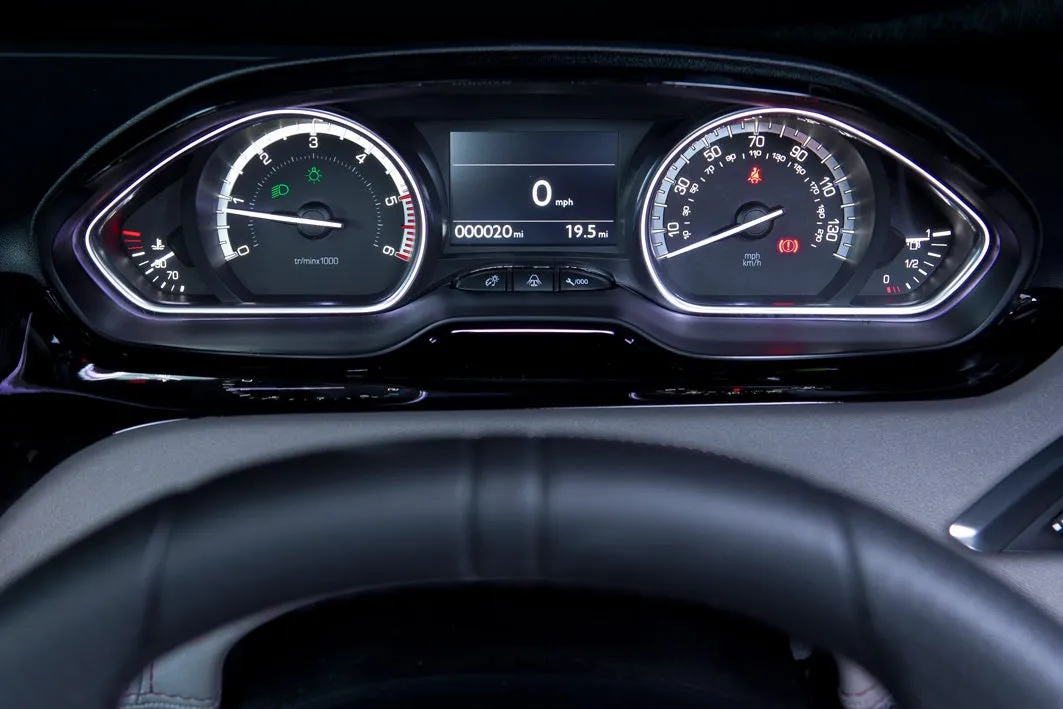
Another reason we like the Puretech 110 engine is its staggering official fuel economy of 65.7mpg. The trouble is, its sheer effervescence and punchy feel means you’re unlikely to show the restraint to get near this, but it’s still likely to prove a fuel-efficient motor.
The diesels are excellent. The 1.6 BlueHDi 100 with start-stop was rated at 94.2mpg under the contemporary fuel economy tests. Again, this is unrealistic in everyday use, but it’s still certain to prove very efficient. Even the earlier 1.6 e-HDi 92 manages almost 80mpg in official claims.
How reliable is a Peugeot 208?
The Peugeot 208 scored a very poor 6.17 out of 10 for reliability in the HonestJohn.co.uk Satisfaction Survey, which is not only the lowest-scoring Peugeot but one of the lowest rated cars in this respect. This is backed up by several recalls having been issue for the 208, but as with any used car it is crucial to check that this work has been carried out.
Peugeot as a brand didn't do very well either, being placed 24th out of 29 manufacturers overall in the 2023 survey. This doesn't mean you should discount the Peugeot 208 altogether, just that you should proceed with care as you would buying any used car and look for a car with a full main dealer service history.
Insurance groups and costs
Pick the right Peugeot 208 and you’ll enjoy impressively affordable insurance costs. A basic Access 1.0-litre comes in at group five, moving up to group six for the more desirable Access, and even 1.2-litre versions are in group eight. This helps keep insurance costs down for the cheapest 208.
The diesels are a little more expensive, and there’s a surprising jump up to group 15 or 16 for the 1.6-litre e-HDI Active. We’re surprised to see a 1.6 BlueHDi 100 Allure weighing in at group 20, which is why you’re probably better off sticking with the sweeter petrol engines. Oh, and another word of warning: we love the 1.2-litre Puretech 110 engine, but in appealing GT Line trim, a group 18 insurance rating seems a bit too high for comfort.
Take the sporty 208 GTI and its insurance raises the stakes again as it sits in groups 32 to 34 depending on the exact trim you pick.
VED car tax: What is the annual road tax on a Peugeot 208?
Ultra-low CO2 emissions mean the Peugeot 208 is a cost-effective car in terms of VED (road tax). The lowest-power 68PS and 1.2-litre 82PS versions only cost £20 a year. Most of the diesels are free to tax, although the larger engines are pricier – the 1.6 VTI 120, for example, costs £160 a year (without offering that much extra power compared with the 1.2).
Although the 1.2 Puretech 110 will cost you a bit more in terms of insurance, you will save on VED. Its CO2 emissions of 103g/km mean a £20 annual tax bill, which should offset any extra costs in terms of insurance compared to the thirsty 1.6-litre 120. Remember, you’ll save on fuel bills, too.
For any Peugeot 208 registered on or after 1 April 2017, they will pay road tax at the flat rate of £190 per year.
How much should you be paying for a used Peugeot 208?
"We love how you can buy an early Peugeot 208 for less than £3000. They will be 1.2-litre VTI cars, probably in base Active spec, although there’s the odd 1.4-litre VTI Allure thrown in there if you don’t mind higher miles (and higher fuel bills). These cars still look fresh and modern, and show why the Peugeot 208 range is becoming an increasing appealing used car buy."
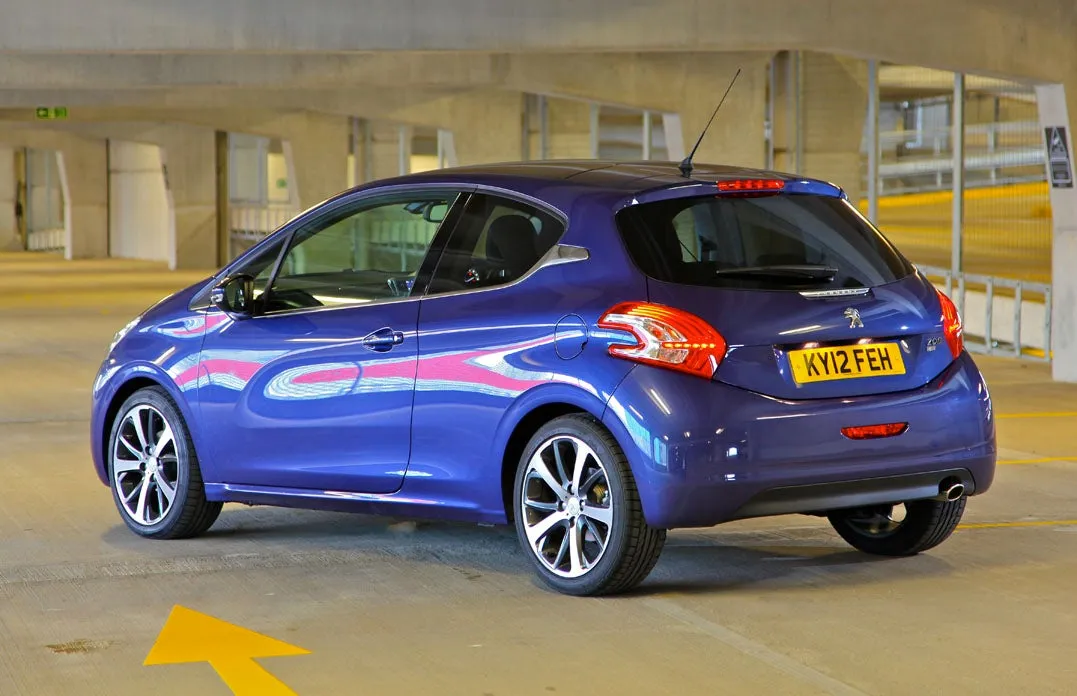
Up your budget to £5000 and there’s plenty more choice from the pre-facelift model range, including some really well-equipped Allure and Feline models. This is also the point at which facelifted models come into reach. They’ll probably have higher mileage and will be entry-level 1.0-litre versions, but it’s still impressive that you can get into a refreshed Peugeot 208 for so little.
If you can afford £6000 upwards, there’s a wide array of desirable facelifted Peugeot 208 models on sale, including the choice 1.2-litre engine. It was a popular car, so there’s a broad choice of colours and trims: pick a five-door with the touchscreen display (for Apple CarPlay and smartphone MirrorLink), and you’ll have a bargain entry point into a car that still feels contemporary, but won’t lose you a fortune in depreciation over the next couple of years.
An early 208 GTI will cost around £4000 for one with 75,000 miles on the clock, while one from the end of the model's production life will come in at £10,000 with 40,000 miles showing on the dials.
Trim levels and standard equipment
The basic Peugeot 208 Access didn't even have alloy wheels, but did have cruise control and a speed limiter. Access+ trim added electric door mirrors and manual air-con, but Active is the preferred entry point: it has alloy wheels, a colour touchscreen, USB, Bluetooth, DAB and split-fold rear seats.
The Peugeot 208 Allure has LED running lights, larger 16-inch alloys, dark rear glass, climate control, leather steering wheel and auto lights and wipers. Posh Peugeot 208 Feline models have even larger 17-inch alloys, sat-nav, a panoramic glass roof and ambient lighting. Peugeot also offered an upmarket 208 XY variant, which it intended to be a luxury alternative to the GTI, with sports seats, LED indicators and a white LED instrument surround.
Post-facelift, the appealing Peugeot 208 GT-Line grade was introduced. This has some of the features from the range-topping Peugeot 208 GTI, paired with a more economical range of engines. You can even get it in some of the bright post-facelift colours, such as vivid orange with lime green exterior accents. It’s worth noting that all 2015-on 208s have air-con and Bluetooth as standard.
The GTI was also offered as the GTi Prestige with sat-nav and heated seats, while the GTi by Peugeot Sport added Alcantara seats, along with unique sports suspension and styling.
Ask the heycar experts: common questions
Is the Peugeot 208 a good buy?
When did they stop making the Peugeot 208?
Is the Peugeot 208 a good family car?
Get our latest advice, news and offers
Keep me updated by email with the latest advice, news and offers from heycar.
By submitting you agree to our privacy policy



